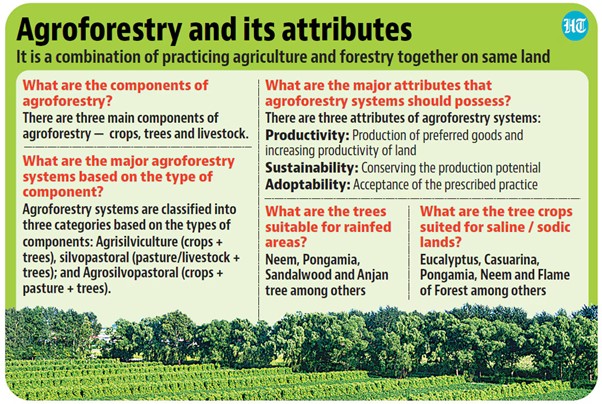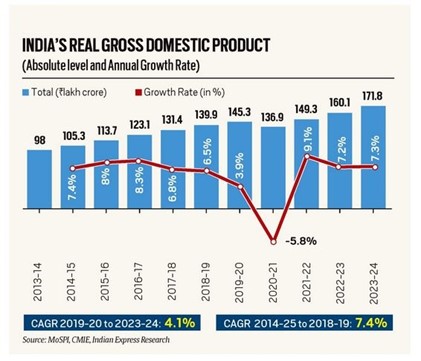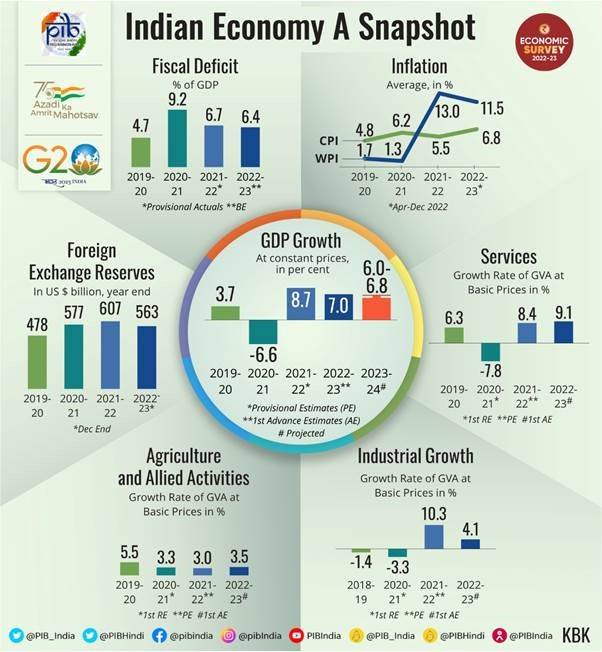Contents:
- Common Practice Standards Must Have an India-Centric Outlook for Carbon Finance Projects
- Demand Flux: India’s Growth Dynamics May Falter with Waning Urban Consumption
- A Rice Variety to Curb Farm Fires: Pusa-2090’s Potential for Sustainable Farming
Common Practice Standards Must Have an India-Centric Outlook for Carbon Finance Projects
Context:
India’s agroforestry sector has substantial potential to contribute to global carbon finance through afforestation, reforestation, and revegetation (ARR) initiatives. With the right incentives and policies, India could double its agroforestry area by 2050, significantly enhancing its carbon sink capacity. However, existing global carbon standards often do not consider India’s fragmented, smallholder-dominated land patterns, limiting farmers’ participation in carbon credit projects. Revising these standards to suit Indian conditions is crucial for achieving environmental sustainability and economic development.
Relevance: General Studies Paper 3 (Environment, Climate Change, and Sustainable Development).
Mains Question: Analyze the challenges faced by India’s agroforestry sector in participating in global carbon finance projects. How can ‘Common Practice Standards’ be revised to better suit India’s unique agricultural landscape? (250 words)

- India’s Potential in the Agroforestry Sector:
India’s agroforestry area currently covers 28.4 million hectares, contributing 8.65% of India’s total land area. The sector stores 19.3% of India’s carbon stocks. Expanding agroforestry to 53 million hectares by 2050 could add an additional 2.5 billion tonnes of CO₂ equivalent to the country’s carbon sink. - Current Barriers in Carbon Standards:
Global carbon finance platforms use a ‘Common Practice’ criterion to determine project eligibility for carbon credits. This standard often aligns with large-scale, contiguous landholdings typical of countries like the US, Latin America, or Africa. In contrast, 86.1% of Indian farmers operate on small, fragmented plots, making them ineligible for carbon credits under existing frameworks. - Need for India-Centric Standards:
Indian farmers use diverse agroforestry methods, such as planting trees along field boundaries or integrating agroforestry within agricultural landscapes. These small-scale, localized practices are not recognized as “additional” by global standards, excluding many Indian farmers from accessing carbon finance. Revising the standards to include smallholder-dominated landscapes would enable millions of farmers to participate and earn carbon credits. - Benefits of an Inclusive Approach:
Adopting India-specific standards would not only provide income diversification for farmers but also promote sustainable land-use practices. Participating in carbon finance projects can enhance soil fertility, reduce erosion, and improve water retention. These benefits align with broader goals of climate adaptation and rural development. - Successful Examples in India:
Organizations like the Energy and Resources Institute (TERI) have piloted ARR projects in seven states, benefiting over 56,600 farmers. These initiatives show that with supportive standards and frameworks, small and marginal farmers can successfully engage in carbon credit markets. However, scaling up requires revising ‘Common Practice’ guidelines to align with the realities of India’s fragmented landholding patterns. - Role of International Carbon Platforms:
Platforms like the Verified Carbon Standard (VCS) or Gold Standard need to expand their criteria to accommodate India’s land structure. They should recognize incremental changes such as planting trees along field boundaries or restoring degraded forest areas. This would ensure that Indian projects contribute meaningfully to carbon sequestration and are acknowledged for carbon credits. - Strategic Importance for India:
India’s agroforestry sector has the potential to become a global leader in sustainable agriculture. Revising standards will unlock the carbon finance market for millions of smallholders, providing economic resilience and contributing to national climate goals. A more inclusive approach can also position India as a key player in international climate negotiations, showcasing its commitment to sustainability.
Latest Data and Numbers:
- Current agroforestry area: 28.4 million hectares.
- Potential agroforestry area by 2050: 53 million hectares.
- Contribution to India’s carbon sink: 19.3% of national carbon stocks.
- Potential carbon addition: 2.5 billion tonnes of CO₂ equivalent by 2050.
- India’s smallholder farming: 86.1% of farmers operate on less than 2 hectares.
Conclusion:
India’s agroforestry sector presents a unique opportunity to integrate with global carbon finance if international standards are revised to suit its landscape. Revising ‘Common Practice’ standards to recognize smallholder and fragmented landholdings will empower millions of farmers to participate in carbon credit markets, promoting both economic and environmental benefits. Aligning these standards with India’s needs is crucial to realizing the full potential of agroforestry and achieving sustainable development.
Implementing India-centric carbon finance standards would be a transformative step in scaling up agroforestry projects, ensuring that the sector achieves its dual goals of environmental sustainability and rural economic development.
Demand Flux: India’s Growth Dynamics May Falter with Waning Urban Consumption
Context:
India’s GDP growth for 2023-24 reached 8.2%, but there are warning signs, especially in the form of faltering urban consumption and a struggling farm sector. While the farm sector’s slowdown is attributed to erratic monsoons, private consumption growth remains low. The decline in urban demand, if unaddressed, could hinder overall economic growth, affecting investment cycles and job creation.
Relevance: General Studies Paper 3 (Economic Development, Growth, and Inflation Management).
Mains Question: Analyze the recent trends in India’s consumption patterns and their implications on economic growth. Discuss measures that could be taken to stimulate urban demand. (250 words)

- Current Growth Scenario:
India’s GDP grew by 8.2% in 2023-24, but private consumption expenditure (PFCE) grew only by 4%, which is less than half of the overall economic pace. This is the weakest consumption growth since 2002-03, excluding the pandemic-hit 2020-21. - Sectoral Slowdown:
The farm sector’s slowdown due to an erratic monsoon dampened rural demand. Economists observed a K-shaped consumption pattern, with high-end goods and services seeing better growth than essential goods. This disparity indicates weakening consumption in lower economic segments. - Urban Demand and Inflation Concerns:
Urban demand, which was expected to support the economy, is also showing signs of fatigue. The Reserve Bank of India’s (RBI) Consumer Confidence Survey for July 2024 showed a decline in consumer optimism. High inflation, especially in food prices, has reduced the ability of urban consumers to spend on discretionary items. - Impact on Economic Growth:
A slowdown in consumption could disrupt the virtuous cycle of investment, job creation, and higher consumption, leading to a negative spiral. Lower demand affects industrial capacity utilization, reducing private investments and delaying new projects. - Key Indicators to Monitor:
The Finance Ministry highlighted a dip in passenger vehicle sales from April to August 2024 as a sign of weakening urban demand. S&P Global Ratings has downgraded India’s growth expectation to 6.8% for this fiscal year, indicating that high interest rates are tempering consumption. - Policy Recommendations:
The government needs to consider measures to stimulate demand, particularly in urban areas. Strategies could include passing on the benefits of reduced global oil prices to consumers and cutting taxes on retail fuel prices to increase disposable income. - Rural Consumption Trends:
On a positive note, rural demand has shown signs of recovery, driven by higher real wage growth and cooling inflation. Two-wheeler sales and other rural indicators have improved, suggesting a possible revival in rural consumption. - Long-Term Measures Needed:
Structural reforms to boost disposable incomes, reduce inflationary pressures, and support employment generation are crucial. Additionally, targeted interventions like relief in income tax slabs or subsidies could help increase consumer spending.

Latest Data and Numbers:
- GDP growth for 2023-24: 8.2%.
- PFCE growth: 4% (lowest since 2002-03, excluding 2020-21).
- S&P Global’s revised GDP growth projection: 6.8%.
- Urban consumption trends: Dip in passenger vehicle sales from April-August 2024.
Conclusion:
India’s robust GDP growth is threatened by declining urban consumption and a fragile rural economy. Without targeted policy interventions, the current growth momentum may not sustain. Addressing these concerns through demand-side measures and stabilizing inflation is vital to keep the economy on its growth trajectory.
Effective fiscal measures and careful monitoring of demand dynamics are essential to maintain economic stability and ensure inclusive growth across both urban and rural sectors.
A Rice Variety to Curb Farm Fires: Pusa-2090’s Potential for Sustainable Farming
Context:
Pusa-2090, a new rice variety developed by the Indian Agricultural Research Institute (IARI), could play a crucial role in reducing stubble burning in Punjab and Haryana. This new variety, which matures 30-35 days earlier than the widely grown Pusa-44, can be harvested by early to mid-October, allowing enough time for farmers to prepare for wheat sowing without resorting to stubble burning. With comparable yield levels and shorter growing cycles, Pusa-2090 offers an environmentally friendly and economically viable alternative for farmers.
Relevance: General Studies Paper 3 (Agriculture, Environmental Conservation, and Technology)
Mains Question: Discuss how the adoption of early-maturing rice varieties like Pusa-2090 can contribute to reducing stubble burning in Punjab and Haryana. Analyze its economic and environmental benefits. (250 words)
- The Problem of Stubble Burning:
Stubble burning is a major issue in Punjab and Haryana, contributing to severe air pollution in North India every winter. Farmers burn paddy stubble to quickly clear fields for the next wheat crop due to the short window between harvesting rice and sowing wheat. - Current Popular Varieties:
Pusa-44, the most popular variety in Punjab, takes 155-160 days from sowing to maturity and is harvested around mid-November. The late harvest leaves farmers with no time to clear the fields for wheat sowing, forcing them to burn the stubble. - Introduction of Pusa-2090:
Pusa-2090, developed by IARI, matures in 120 days—30-35 days earlier than Pusa-44. This shorter duration allows harvesting by early October, providing a 25-30 day window before wheat sowing begins. Early harvesting eliminates the need for stubble burning as farmers have enough time to clear the fields manually or mechanically. - Yield and Economic Viability:
Pusa-2090’s yield (35-36 quintals per acre) is nearly equivalent to Pusa-44’s yield, making it a viable option for farmers. Additionally, early harvesting results in water savings, with Pusa-2090 requiring 5-6 fewer irrigations compared to Pusa-44. This translates to significant cost savings and higher net returns. - Environmental Benefits:
Adopting Pusa-2090 can substantially reduce stubble burning, lowering air pollution and improving soil health. Reducing smoke emissions would also alleviate respiratory issues in the region and contribute to meeting air quality standards. - Acceptance Among Farmers:
Farmers like Harpreet Singh from Punjab, who have experimented with Pusa-2090, report satisfaction with its yield and the additional time it provides for land preparation. The Punjab government’s decision to ban Pusa-44 and promote Pusa-2090 through subsidies indicates a policy shift towards sustainable farming. - Long-Term Implications:
Widespread adoption of early-maturing varieties like Pusa-2090 can change the crop cycle dynamics in North India, reducing the environmental footprint of paddy cultivation. This shift can be supported by government incentives, awareness programs, and easy access to seed varieties.
Latest Data and Numbers:
- Pusa-2090 maturation period: 120 days.
- Pusa-44 maturation period: 155-160 days.
- Pusa-2090 yield: 35-36 quintals per acre (similar to Pusa-44).
- Potential water savings: 5-6 fewer irrigations compared to Pusa-44.
Conclusion:
The introduction of Pusa-2090 is a promising solution to the perennial problem of stubble burning in Punjab and Haryana. Its early maturation and comparable yields make it economically attractive to farmers. Policymakers should focus on promoting such varieties to create a sustainable agricultural model that benefits both the environment and farmers.
Encouraging the adoption of Pusa-2090 through targeted support and extension services could pave the way for sustainable agriculture in the region, mitigating the negative impact of stubble burning and ensuring long-term environmental and economic benefits.





